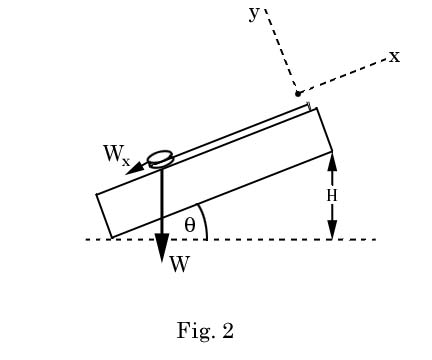
A simple pendulum is a small object (mass m) suspended at the end of a string. "Simple" means that almost all of the system's mass can be assumed to be concentrated in the object; the string's mass is small. The period of the pendulum, T, is the time for the pendulum to swing from the right to the left and back to the right again. The period is given by the equation:
|
| (1) |
where L is the length of the pendulum and g is the acceleration of gravity. The period is precisely independent of m, which reflects the fact the the acceleration of gravity is independent of m. The period does depend slightly on the amplitude of the motion, the angle a, defined in Fig. 1, but for fairly small angles Eq. (1) is quite accurate.

Most experiments with the pendulum involve investigating the dependence of T on L, m and a. In this experiment we will investigate the dependence of the period on L and g.
To do this, we won't travel to the moon, where the acceleration of gravity is different. We will place the pendulum on a frictionless air table, tilted at an angle q with the horizontal (Fig. 2).

In this arrangement the y-component of the weight is balanced by the normal force of the table, and it is only the x-component that causes the swing of the pendulum,
|
| (2) |
Therefore Eq. (1) is replaced by
where the "effective g" is given by, geff = g sin q. Hence we have
|
| (3) |
Note that since the center-of-gravity of the disk is at its center, the length of the pendulum is
where R is the radius of the disk.
We will do one experiment with fixed q and variable L, and one experiment with fixed L and variable q. For each choice of these two independent variables, determine the period by letting the pendulum execute 10 swings. Hold the disk to the right and release it from rest. Let it swing once or twice before starting the electronic clock. Measure the time for 10 swings and then divide by 10. [In a few cases, where the motion is quite slow (large L and small q) you might use 5 swings.] Do each measurement 3 times, and average the 3 to find the best value for the period.
The amplitude angle, a, from which the disk is released, should be the same for all runs. Use a protractor to set a, but this needs to be done only approximately, since the dependence of the period varies only slightly with amplitude. Choose a such that for the largest value of L (60 cm) the pendulum swings almost from the side wall of the table.
To set q at a certain value, say 30 degrees, calculate the height, H, to which the end of the table must be raised (where it is attached to the vertical post). The height and the angle don't have to be set exactly. In good experimental technique you don't try to set an independent variable exactly. You set it approximately, and then measure it exactly.
To set a given length, L, determine the length of string needed, and loop the string once around the wire on the upper end of the air table. Don't tie a knot; just keep the string in place with an alligator clip.
I. Variation of L:
Set q at around 20 degrees. Choose Lstring so that L takes on the values 12, 20, 30, 40, 50 and 60 cm, and measure the period. Plot T vs. L
II. Variation of q:
Set L = 50 cm. Measure the period for q = 12, 20, 30, 45 and 65
degrees. Plot T vs. 1/(sin q)1/2. Determine the best straight line, and find its slope. The theoretical value of the slope is 2 p(L/g)1/2. Compare your measured slope to this, and find the percent error.